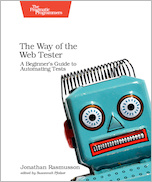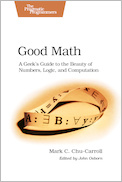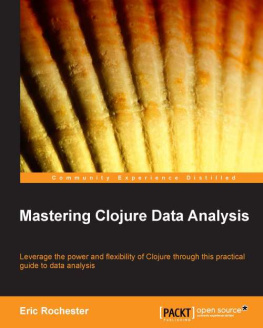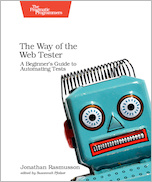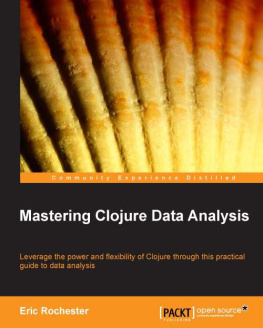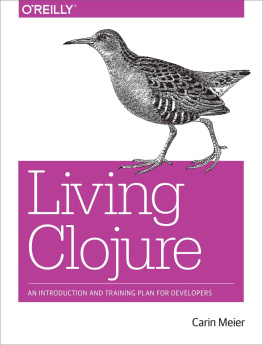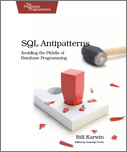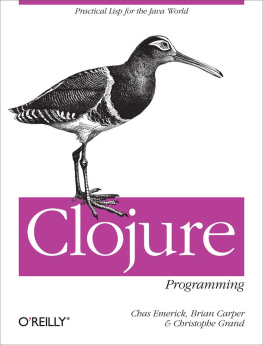Henry Garner [Henry Garner] - Clojure for Data Science
Here you can read online Henry Garner [Henry Garner] - Clojure for Data Science full text of the book (entire story) in english for free. Download pdf and epub, get meaning, cover and reviews about this ebook. year: 2015, publisher: Packt Publishing, genre: Home and family. Description of the work, (preface) as well as reviews are available. Best literature library LitArk.com created for fans of good reading and offers a wide selection of genres:
Romance novel
Science fiction
Adventure
Detective
Science
History
Home and family
Prose
Art
Politics
Computer
Non-fiction
Religion
Business
Children
Humor
Choose a favorite category and find really read worthwhile books. Enjoy immersion in the world of imagination, feel the emotions of the characters or learn something new for yourself, make an fascinating discovery.
- Book:Clojure for Data Science
- Author:
- Publisher:Packt Publishing
- Genre:
- Year:2015
- Rating:4 / 5
- Favourites:Add to favourites
- Your mark:
Clojure for Data Science: summary, description and annotation
We offer to read an annotation, description, summary or preface (depends on what the author of the book "Clojure for Data Science" wrote himself). If you haven't found the necessary information about the book — write in the comments, we will try to find it.
Statistics, big data, and machine learning for Clojure programmers
About This Book
- Write code using Clojure to harness the power of your data
- Discover the libraries and frameworks that will help you succeed
- A practical guide to understanding how the Clojure programming language can be used to derive insights from data
Who This Book Is For
This book is aimed at developers who are already productive in Clojure but who are overwhelmed by the breadth and depth of understanding required to be effective in the field of data science. Whether youre tasked with delivering a specific analytics project or simply suspect that you could be deriving more value from your data, this book will inspire you with the opportunitiesand inform you of the risksthat exist in data of all shapes and sizes.
What You Will Learn
- Perform hypothesis testing and understand feature selection and statistical significance to interpret your results with confidence
- Implement the core machine learning techniques of regression, classification, clustering and recommendation
- Understand the importance of the value of simple statistics and distributions in exploratory data analysis
- Scale algorithms to web-sized datasets efficiently using distributed programming models on Hadoop and Spark
- Apply suitable analytic approaches for text, graph, and time series data
- Interpret the terminology that you will encounter in technical papers
- Import libraries from other JVM languages such as Java and Scala
- Communicate your findings clearly and convincingly to nontechnical colleagues
In Detail
The term data science has been widely used to define this new profession that is expected to interpret vast datasets and translate them to improved decision-making and performance. Clojure is a powerful language that combines the interactivity of a scripting language with the speed of a compiled language. Together with its rich ecosystem of native libraries and an extremely simple and consistent functional approach to data manipulation, which maps closely to mathematical formula, it is an ideal, practical, and flexible language to meet a data scientists diverse needs.
Taking you on a journey from simple summary statistics to sophisticated machine learning algorithms, this book shows how the Clojure programming language can be used to derive insights from data. Data scientists often forge a novel path, and youll see how to make use of Clojures Java interoperability capabilities to access libraries such as Mahout and Mllib for which Clojure wrappers dont yet exist. Even seasoned Clojure developers will develop a deeper appreciation for their languages flexibility!
Youll learn how to apply statistical thinking to your own data and use Clojure to explore, analyze, and visualize it in a technically and statistically robust way. You can also use Incanter for local data processing and ClojureScript to present interactive visualisations and understand how distributed platforms such as Hadoop sand Sparks MapReduce and GraphXs BSP solve the challenges of data analysis at scale, and how to explain algorithms using those programming models.
Above all, by following the explanations in this book, youll learn not just how to be effective using the current state-of-the-art methods in data science, but why such methods work so that you can continue to be productive as the field evolves into the future.
Style and approach
This is a practical guide to data science that teaches theory by example through the libraries and frameworks accessible from the Clojure programming language.
Downloading the example code for this book. You can download the example code files for all Packt books you have purchased from your account at http://www.PacktPub.com. If you purchased this book elsewhere, you can visit http://www.PacktPub.com/support and register to have the files e-mailed directly to you.
Henry Garner [Henry Garner]: author's other books
Who wrote Clojure for Data Science? Find out the surname, the name of the author of the book and a list of all author's works by series.

![Henry Garner [Henry Garner] Clojure for Data Science](/uploads/posts/book/119600/thumbs/henry-garner-henry-garner-clojure-for-data.jpg)
